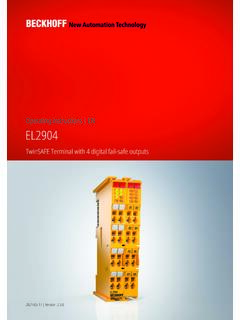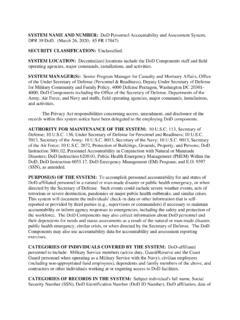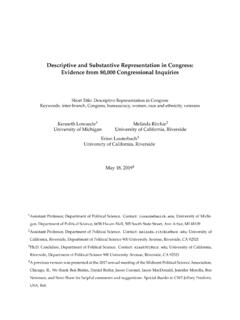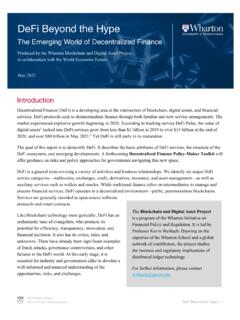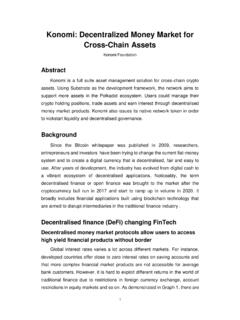Transcription of Basic Attention Token (BAT)
1 Basic Attention Token (BAT)Blockchain Based Digital AdvertisingBrave SoftwareFebruary 10, 2021 AbstractDigital advertising is broken. The marketplace for online advertising, once domi-nated by advertisers, publishers and users, has become overrun by middleman adexchanges, audience segmentation, complicated behavioral and cross-device usertracking, and opaque cross-party sharing through data management face unprecedented levels of malvertisements and privacy violations. Mo-bile advertising results in as much as $23 per month in data charges on the averageuser s data plan, slow page loads, and as much as 21% less battery life. In response,over 600 million mobile devices and desktops (globally) employ ad blocking soft-ware and this number is growing. Traditional publishers have lost approximately66% of their revenue over the past decade, adjusted for inflation. Publishers facefalling revenue, users feel increasingly violated, and advertisers ability to assesseffectiveness is diminished.
2 The solution is a decentralized , transparent digital adexchange based on Blockchain. The first component is Brave, a fast, open source,privacy-focused browser that blocks third party ads and trackers, and builds in aledger system that measures user Attention to reward publishers accordingly. Bravewill now introduce BAT ( Basic Attention Token ), a Token for a decentralized adexchange. It compensates the browser user for Attention while protecting connects advertisers, publishers, and users and is denominated by relevantuser Attention , while removing social and economic costs associated with existingad networks, , fraud, privacy violations, and malvertising. BAT is a paymentsystem that rewards and protects the user while giving better conversion to ad-vertisers and higher yield to publishers. We see BAT and associated technologiesas a future part of web standards, solving the important problem of monetizingpublisher content while protecting user Value Proposition32 An Inefficient and Troubled Market.
3 The Attention Marketplace: ..43 A New Deal: Attention -based Economics on Basic Attention Metrics (BAM) .. Token Technology .. Tokens Used as Publisher Payment .. Tokens for User Applications .. Roadmap ..184 Business Competition .. BAT Advantage Matrix .. BAT Overview .. Key Team Members ..215 Token Token Launch summary .. Token Distribution .. User Growth Pool .. Budget Allocation ..236 BAT FAQs247 A More Efficient Market: Coase Theorem .. A Three-Way Coasean Bargain .. An Analysis of the Stability of the BAT ..3221 Value PropositionWe propose the BAT as a Token of exchange in a secure, anonymous, opt-in advertisingsystem based in the browser and the mobile app webview. The BAT system provides: Users: strong privacy and security when viewing advertisements, improved rele-vance and performance, and a share of tokens. Publishers: improved revenue, better reporting, and less fraud.
4 Advertisers: less expensive customer Attention , less fraud, and better Introduction Attention has been widely recognized as a commodity, like wheat, pork belliesor crude oil. Existing industries have long depended on it to drive sales. Andthe new industries of the twentieth century turned it into a form of currencythey could mint. Beginning with radio, each new medium would attain itscommercial viability through the resale of what Attention it could capture inexchange for its free content. -Tim Wu, Attention BrokersThe promise of advertising technology ( ad-tech ) was to create a more efficientmarketplace for Attention . The hope was that the Internet, the latest kind of newmedium, would arrive with a transparent and efficient ad theory, excellence would be rewarded. The best journalism and entertainmentwould receive the Attention and funding it deserved. Ad tech would get marketerscloser to their users via data analysis, immediate valuation and distribution.
5 Datawould be used to accurately identify audiences, determine the value of those audiences,and deliver the right messages to them instantly. [1] In short, users Attention would bevalued didn t happen. Instead, the ad-tech ecosystem that has evolved over the lasttwo decades is a bewildering variety of middlemen and complexity. Worse, ad-techintroduced a host of correlated problems for publishers, advertisers and users. Usershave lost their privacy, face increasing malware, pay high charges to download ads, andsuffer slow speeds. Publishers have lost billions in revenue while fraud has advertisers face poor reporting and paper will review the current state of ad-tech and the predicament of con-tent producers. It will outline a new solution that creates a transparent and efficientBlockchain-based marketplace for publishers, advertisers and users, accurately valuingand rewarding the key driver of Internet content: durable user An Inefficient and Troubled MarketThomas Davenport and JC Beck note that Attention is focused mental engagementon a particular item of information.
6 Items come into our awareness, we attend to a3particular item, and then we decide whether to act. [2] Attention is, in this sense, aform of scarcity, which raises fundamental economic questions, which we shall , throughout history, has been used as the primary mechanism to captureAttention, raise it to a level of Interest to incite some Desire that can then translateit into Action otherwise known as AIDA.[3] The earliest forms of advertising dateto ancient China, Egypt and the Middle Ages in Europe. The print form of advertis-ing began to expand widely with the growth of 19th Century printed products. Thismarketplace of advertisers, publishers and users remained relatively straightforward despite some additions even as the new media of radio and television rise of the Internet brought the development of a new level of advertising tech-nology with the promise of higher speed and better information, two critical elementsthat had the potential to radically improve the efficiency of the Attention counter-intuitively, the sheer complexity and opacity that organically devel-oped has brought the opposite result.
7 The system isn t working as it should. As theChief Brand officer of the largest advertiser, P&G, said recently: The days of giving digital a pass are over. It s time to grow up. It s timefor action. [4]Especially in the last decade, the advertising ecosystem has become more complexand crowded, with many more players taking a piece of the advertising pie, eitherdirectly or indirectly. The complexity of this ecosystem increases the cost in headcountand difficulty of the tasks for the digital marketing teams on the advertiser s side. Atthe other end of the system, the typical publisher faces both a shrinking market for thead-blocker-free Attention , and a shrinking slice of the advertising revenue pie due to themultitude of third party players who act as economic middlemen in the The Attention Marketplace:Sales planners currently budgeting for brand advertising are required to account foran excessive number of intermediaries that stand between the ad and the end , trading desks, demand side platforms, desktop and mobile network exchanges,yield optimization, rich media vendors and partnered services often consume significantportions of creative and delivery ad budget.
8 It is also common for agencies in chargeof packaging brand campaigns to use data aggregators, data management platforms, data suppliers, analytics, measurement and verification services to fight fraud, enhancetargeting, and confirm attribution. These factors add up to a high transaction cost onthe efficient provision of Attention to brand ad also face a number of costs and intermediaries on the receiving side ofthe ads served. Publishers pay ad serving fees, operational fees for campaign setup,deployment and monitoring, publisher analytics tools; also they give up substantialrevenue to some of the same intermediaries that the brand advertisers use via program-matic ads. Publishers face direct costs of user complaints when malvertising spreadsfrom exchanges to loyal readers, often with little or no idea of origin and with no helpfrom the ad exchanges responsible for allowing such ads to serve from their diminish net revenue as the overall complexity of the advertising ecosystem raisesheadcount and is a hidden cost to this complexity.
9 A single ad unit may bounce acrossmany networks, buy and sell-side ad servers, verification partners and data managementplatforms. Publishers lose revenue from each middleman transaction. Each one ofthese transactions also detracts from the user experience. Many of the middle playersinvolve data transfers, which add latency. Any transfers done via script on page eatinto the user s data plan and battery life on mobile. Users often find their experiencefurther diminished when the results finally arrive, confounded by a bewildering arrayof distracting ads the publisher allowed to be placed in hope of greater addition, the violation of user privacy exacts a significant social cost; economistshave compared violations of user privacy as analogous to environmental pollution.[5]According to Pew Research, Fully 91% of adults agree or strongly agree that users havelost control of how personal information is collected and used by companies.
10 [6] A largemajority, 64%, believe that the government should do more to regulate advertisers regarding how they use and store personal information. This is not surprising, giventhat a visit to a popular media site can often have 70 trackers set loose on the is also a major problem afflicting the advertising marketplace. Hackers cre-ate malicious bots that produce bogus websites that fool advertisers. Internet bots, 5 Figure 1: Typical Digital Ad FlowFigure 2: Typical Tracking on Large Content Sites6 Figure 3: data Transferred by data Elements on News Sitesremote-controlled software running on compromised personal computers or cloud in-frastructure programmed to engage in criminal activities -siphon billions of dollars eachyear from the ad industry. According to Business Intelligence: These bots create web-sites filled with infringed content and generate fake traffic through a complex networkof infected computers. In 2016, ad fraud created by internet bots is expected to costadvertisers $ billion, up from $ billion in 2015, according to a report from theAssociation of National Advertises (ANA) and White Ops.



